
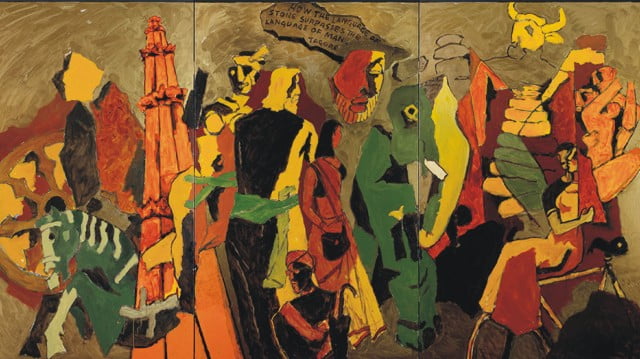
India and Pakistan are both passing through a very turbulent and painful transitional period in our history –transition from a feudal to a modern society.
It is a period when there is tremendous turmoil and social churning, as the old society is being uprooted, but the new society has not yet been born, when old values are crumbling, but new values have not yet been established.
As Shakespeare said in Macbeth “Fair is foul and foul is fair“, i.e. what was regarded good earlier is regarded bad today, and vice versa.
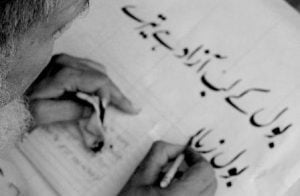 There are many verses in Urdu poetry which reflect the transitional period in our history. Urdu shers (couplets) are a remarkable condensation of ideas which may take a volume to narrate.
There are many verses in Urdu poetry which reflect the transitional period in our history. Urdu shers (couplets) are a remarkable condensation of ideas which may take a volume to narrate.
Before dealing with them I may repeat what I wrote in my article ‘The true meaning of Faiz‘ poem – Gulon mein rang bharey‘:
” Urdu poetry is often written not directly, but in a round about way, by allusions, hints, indications and suggestions. It often has a superficial, literal, outer meaning, and an inner, deeper, real meaning, to understand which one has to wrack one’s brains.
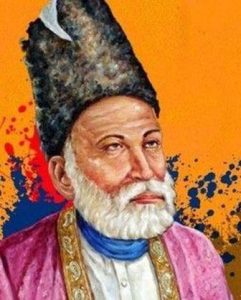
Great Urdu poets like Ghalib believed that poetry should not be written in the language of the common man, and they had a horror of the commonplace in poetry. To make it dignified and sophisticated (andaaz-e-bayaan) they often used Persian expressions and metaphors”.
So I will have to explain these verses depicting the transitional era :
1. We may take two shers from Ghalib‘s famous nazm ‘Bazeecha-e-atfaal hai duniya mere aage‘ :
“Imaan mujhe roke hai, jo khainche hai mujhe kufr
Kaaba mere peeche hai, kaleesa mere aage”
Which literally means:
“Faith is holding me up, atheism is pulling me forward
Kaaba is behind me, the church is in front”
But here the words ‘Kaaba‘ (the holiest place for Muslims) and ‘Kaleesa‘ (i.e. church) must not be read literally.
As I have explained earlier, Urdu poetry often has a superficial, literal, outer meaning, and a deeper, real, inner meaning, which the poet is conveying by hints, allusions, suggestions, and metaphors.
Kaaba here denotes feudalism, and Kaleesa denotes modernism. So what Ghalib is trying to say is that we should give up feudalism and become modernised.
“Hai maujazan ek qulzum-e-khoon kaash yahi ho
Aata hai abhi dekhiye kya kya mere aage”
i.e.
“A turbulent sea of blood is before me
But see what all comes hereafter”
In a transitional era there is often a lot of bloodshed. For example, when Europe was passing through its transition from a feudal to a modern society (from the 17th to the 19th centuries) this period witnessed tremendous turmoil, wars, revolutions, chaotic conditions, etc.
It was only after going through this fire that modern society emerged in Europe. The Indian subcontinent is presently going through this fire. We are going through a very painful prolonged period in our history, which Ghalib has accurately encapsulated in the above sher.
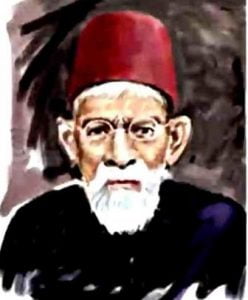
2. Akbar Allahabadi (1846-1921) is regarded by many to be a reactionary poet. However, in the poem whose verses follow, he showed himself as surprisingly progressive, and brilliantly captured in verse the coming changes in society in this transitional age :
“Yeh maujooda tareeke raahi-e-mulk-e-adam honge
Nai tehzeeb hogi aur nae saamaan baham honge
Na khatunon men rah jaegi parde ki ye pabandi
Na ghunghat is tarah se hajib-e-ru-e-sanam honge
Badal jaega andaz-e-taba.e daur-e-gardun se
Nai surat ki ḳhushiyan aur nae asbab-e-gham honge
Na paida hogi ḳhat-e-nasḳh se shan-e-adab-agin
Na nastaliq harf is taur se zeb-e-raqam hooge
Khabar deti hai tehreek-e-hawa tabdeel-e-mausam ki
Khilenge aur hi gul, zamzame bulbul ke kam honge
Badal jaayega meyaar-e-sharaafat chashm-e-duniya mein
Zyaada the jo apne zom mein woh sab se kam honge
Ghuzishta azmaton ke taskare bhi na reh jaayenge
Kitaabon mein hi dafn afsaan-e-jaaho hasham honge
Kisi ko is taghayyur ka na his hogaa na gham hogaa
Hue jis saaz se paida usi ke zeyro bam honge
Tumhe is inqilaab-e-deher ka kya gham hai ai Akbar
Bahut nazdeek hain woh din ki tum hoge na hum honge”.
3. The sher which most powerfully captures the essence of the transition era was written by Firaq Gorakhpuri (1896-1982 ) :
“Har zarre par ek kaifiyat-e-neemshabi hai
Ai Saaqi-e-dauraan yeh gunahon ki ghadi hai”
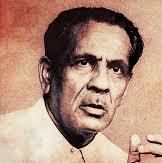
In a marvel of condensation this sher (couplet) reflects the transitional age through which the Indian subcontinent is passing, from feudal society to a modern industrial society. At present we are neither totally feudal nor totally modern, but partly both.
Zarra means particle, kaifiyat means condition, e means of, neem means half, and shab means night. So the first line in the couplet literally means
“Every particle is in a condition of half night”.
Urdu poetry, as mentioned before, is often to be understood figuratively, not literally. So this line really means that (in the transitional age) everything is in flux, neither night nor day, neither the old order nor the new. Also, in the middle of the night if we get up we are dazed, in a state of mental confusion, and so are people in a transitional age.
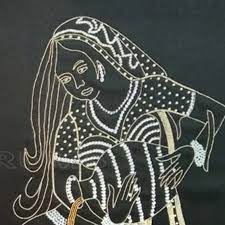
In the second line, saaqi is the girl who fills the wine cup, but she is also the person to whom one can confide the innermost thoughts in one’s mind. The poet is imagining a girl, to whom he is describing the features of the transitional era.
‘Yeh gunahon ki ghadi hai’ means it is the time of sin. In this transitional age it is a ‘gunahon ki ghadi’ from both points of view.
From the point of view of people of the old, feudal order it is a sin to marry according to your choice, and particularly outside one’s caste or religion, it is a sin to give education to women, it is a sin to treat everyone as equal (as feudal Indian society was caste bound).
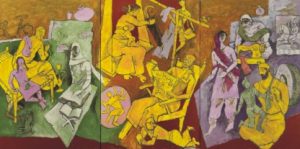
At the same time, from the point of view of modern minded people, the caste system is a sin, denying education to girls is a sin, and love marriage is quite acceptable.
In India, Pakistan and other third world countries we see everywhere disorder, crime, corruption, feudal practices like ‘honour killing’, etc.
It is a ‘gunahon ki ghadi’ (era of sins) from both the point of view of the feudal minded people, as well as from the point of view of the modern minded people. The feudal people regard inter-caste and inter religious love marriages as a gunah [sometimes deserving Honour killing].
They regard dating with a person of the opposite sex before marriage, or sex before marriage, as a gunah (sin). Many such persons regard education for women as a gunah. They regard grant of equality to people of ‘low’ caste as a gunah.
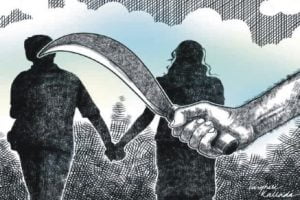 On the other hand, modern minded persons regard ‘honour’ killing as a gunah. They regard keeping a woman uneducated or without equal rights as a gunah. They regard the caste system as a gunah.
On the other hand, modern minded persons regard ‘honour’ killing as a gunah. They regard keeping a woman uneducated or without equal rights as a gunah. They regard the caste system as a gunah.
Thus old and new ideas are clashing and battling with each other in the transitional age. Urdu poetry brilliantly expresses this state of affairs.
The above sher of Firaq is followed by this sher of his :
“Maaloom hai sailabiye sarchashma-e-haiwaan
Bas tashnalabi tashnalabi tashnalabi hai”
This expresses the overpowering desire of the poet for social change (‘tashnalabi‘ means thirst).
This transitional era is likely to continue in our subcontinent for another 15-20 years., after which a modern just social order will be created, in which everyone will get a decent life, i.e. employment, proper education and healthcare, nutritious food, housing, etc. ![]()
Also Read:
यह भी पढ़िये: मेहरबान जज साहिब
Watch video:

Disclaimer : PunjabTodayTV.com and other platforms of the Punjab Today group strive to include views and opinions from across the entire spectrum, but by no means do we agree with everything we publish. Our efforts and editorial choices consistently underscore our authors’ right to the freedom of speech. However, it should be clear to all readers that individual authors are responsible for the information, ideas or opinions in their articles, and very often, these do not reflect the views of PunjabTodayTV.com or other platforms of the group. Punjab Today does not assume any responsibility or liability for the views of authors whose work appears here.
Punjab Today believes in serious, engaging, narrative journalism at a time when mainstream media houses seem to have given up on long-form writing and news television has blurred or altogether erased the lines between news and slapstick entertainment. We at Punjab Today believe that readers such as yourself appreciate cerebral journalism, and would like you to hold us against the best international industry standards. Brickbats are welcome even more than bouquets, though an occasional pat on the back is always encouraging. Good journalism can be a lifeline in these uncertain times worldwide. You can support us in myriad ways. To begin with, by spreading word about us and forwarding this reportage. Stay engaged.
— Team PT


Copyright © Punjab Today TV : All right Reserve 2016 - 2024 |